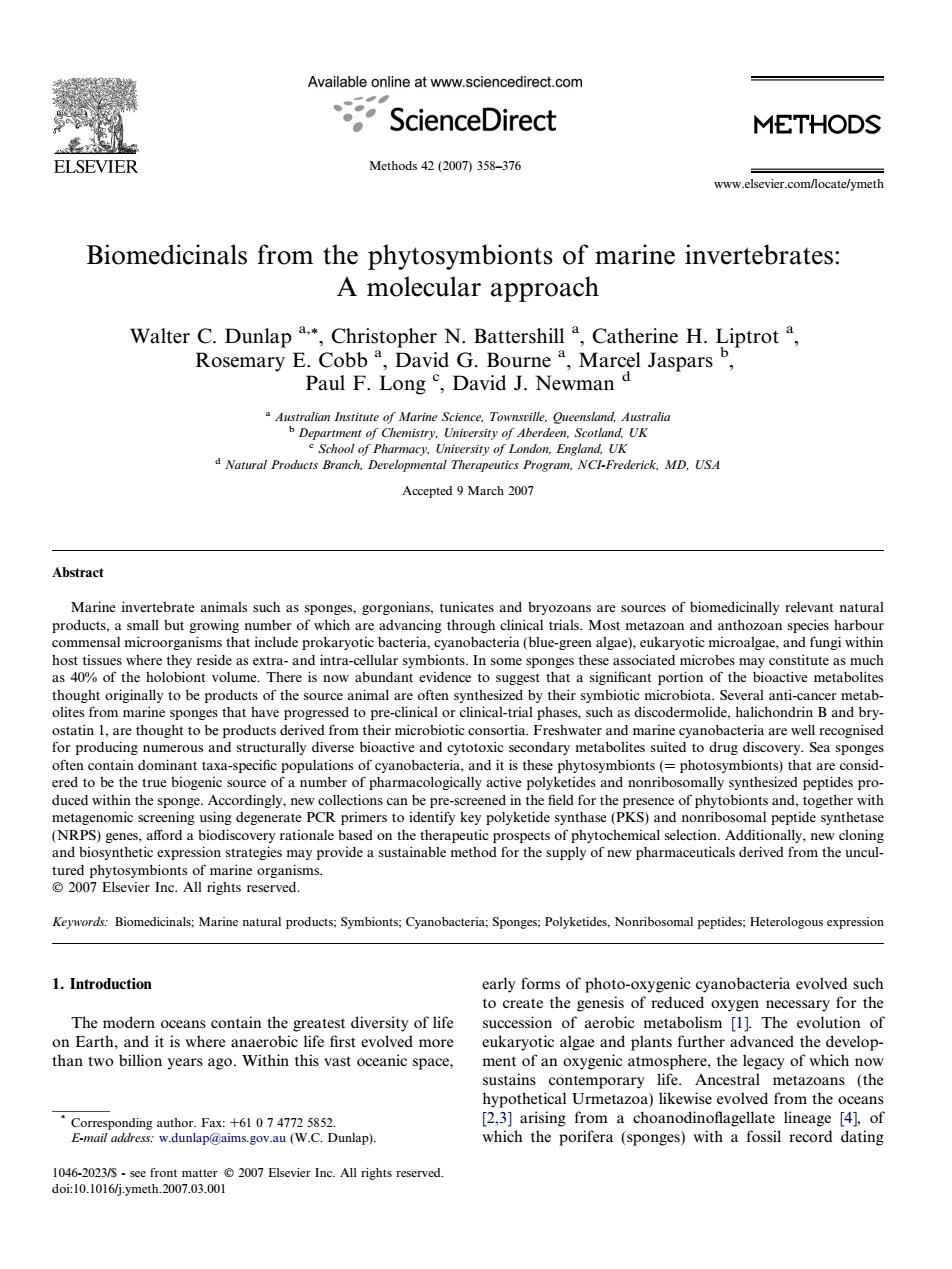正在加载图片...

Available online at www.sciencedirect.com ScienceDirect METHODS ELSEVIER Methods42(2007)358-376 www.eisevier.com/ocate/ymeth Biomedicinals from the phytosymbionts of marine invertebrates: A molecular approach Walter C.Dunlap,Christopher N.Battershill a,Catherine H.Liptrota, Rosemary E.Cobb,David G.Bourne Marcel Jaspars Paul F.Long,David J.Newman ty of London,Engla nd.UK evelopmental Therapeurics Program.NCI-Frederick.MD.USA Accepted 9 March 2007 Abstract Marine invertebrte animaks suchponge,porgonians,tunicates ad bryoo of biomedicinaly relevant natura umer of wh advancing through Zoan and antho ith host tissues where they reside as extraand intra-cellular symbionts.In some sponges these associated microbes may constitute as much as 40%of the holob ont volume.There is now abundant evidence to suggest t at a significant portion of the bioactive metabolites thought originally to be pro of the source imal are ofn thought to be products derived from ther and marine cyanobacteria are well for and structurally diverse bioactive and condary metabolites suited to drug discovery.Sea sponge cyan teria,and it is sym onts)tha t a duced within the sponge.Accordingly,new collections can be in the field for the presence of phytobionts and,together with PCR primers to identify key polyketide synthase (PKS)and noribosomal peptide synt d b pha tosymbionts of marine organisms. Keywords:Biomedicinals:Marine natural products:Svmbionts:Cva 1.Introduction nic cyanobacteria evolved such for The modern s contain the eatest diversity of life on Earth.and it is where anaerobic life first evolved more eukaryotic algae and plants further advanced the develop than two billion years ago.Within this vast oceanic space, ment of an oxygenie atmosphere the legacy of which now sustains contemporary life.Ancestral metazoans (the hypothetical Urmetazoa)likewise evolved from the oceans utho .Fa+61074772585 2.3 arising from a choanodinoflagellate lineage [4].of which the porifera(sponges)with a fossil record datingBiomedicinals from the phytosymbionts of marine invertebrates: A molecular approach Walter C. Dunlap a,*, Christopher N. Battershill a , Catherine H. Liptrot a , Rosemary E. Cobb a , David G. Bourne a , Marcel Jaspars b , Paul F. Long c , David J. Newman d a Australian Institute of Marine Science, Townsville, Queensland, Australia b Department of Chemistry, University of Aberdeen, Scotland, UK c School of Pharmacy, University of London, England, UK d Natural Products Branch, Developmental Therapeutics Program, NCI-Frederick, MD, USA Accepted 9 March 2007 Abstract Marine invertebrate animals such as sponges, gorgonians, tunicates and bryozoans are sources of biomedicinally relevant natural products, a small but growing number of which are advancing through clinical trials. Most metazoan and anthozoan species harbour commensal microorganisms that include prokaryotic bacteria, cyanobacteria (blue-green algae), eukaryotic microalgae, and fungi within host tissues where they reside as extra- and intra-cellular symbionts. In some sponges these associated microbes may constitute as much as 40% of the holobiont volume. There is now abundant evidence to suggest that a significant portion of the bioactive metabolites thought originally to be products of the source animal are often synthesized by their symbiotic microbiota. Several anti-cancer metabolites from marine sponges that have progressed to pre-clinical or clinical-trial phases, such as discodermolide, halichondrin B and bryostatin 1, are thought to be products derived from their microbiotic consortia. Freshwater and marine cyanobacteria are well recognised for producing numerous and structurally diverse bioactive and cytotoxic secondary metabolites suited to drug discovery. Sea sponges often contain dominant taxa-specific populations of cyanobacteria, and it is these phytosymbionts (= photosymbionts) that are considered to be the true biogenic source of a number of pharmacologically active polyketides and nonribosomally synthesized peptides produced within the sponge. Accordingly, new collections can be pre-screened in the field for the presence of phytobionts and, together with metagenomic screening using degenerate PCR primers to identify key polyketide synthase (PKS) and nonribosomal peptide synthetase (NRPS) genes, afford a biodiscovery rationale based on the therapeutic prospects of phytochemical selection. Additionally, new cloning and biosynthetic expression strategies may provide a sustainable method for the supply of new pharmaceuticals derived from the uncultured phytosymbionts of marine organisms. 2007 Elsevier Inc. All rights reserved. Keywords: Biomedicinals; Marine natural products; Symbionts; Cyanobacteria; Sponges; Polyketides, Nonribosomal peptides; Heterologous expression 1. Introduction The modern oceans contain the greatest diversity of life on Earth, and it is where anaerobic life first evolved more than two billion years ago. Within this vast oceanic space, early forms of photo-oxygenic cyanobacteria evolved such to create the genesis of reduced oxygen necessary for the succession of aerobic metabolism [1]. The evolution of eukaryotic algae and plants further advanced the development of an oxygenic atmosphere, the legacy of which now sustains contemporary life. Ancestral metazoans (the hypothetical Urmetazoa) likewise evolved from the oceans [2,3] arising from a choanodinoflagellate lineage [4], of which the porifera (sponges) with a fossil record dating 1046-2023/$ - see front matter 2007 Elsevier Inc. All rights reserved. doi:10.1016/j.ymeth.2007.03.001 * Corresponding author. Fax: +61 0 7 4772 5852. E-mail address: w.dunlap@aims.gov.au (W.C. Dunlap). www.elsevier.com/locate/ymeth Methods 42 (2007) 358–376��